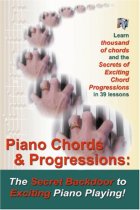How To Turn a Chord Tremolo Into A Rapid-Fire Run On Your Piano
What Is a Chord Tremolo?
| Duane: | Good morning. This is Duane. Today I’d like to cover the subject of how to turn a chord tremolo into a rapid-fire run. Take a chord tremolo of any sort really; let me just take a G7th chord. That’s a G7th chord inverted, isn’t it? I could play it like that, in root position, but it’s easier if I have two of the notes together. It fits my hand better. I’m playing it in 2nd inversion with the 5th on the bottom, then the 7th and the root and the 3rd. A tremolo, of course, is a rapid alternation of all the notes. It’s like that. You’ve heard that sort of thing. It’s just a rapid alternation of notes.
|
| Once you have that tremolo going, to make it turn into a run, all you need to do is to break up the notes of the chord and then tuck your thumb under and do it in the next octave. Then if you want to come back down, you certainly can come back down the same way you went up. Same notes, just you’re going backwards now. See, I’m just playing the notes of the G7th chord, nothing else. It’s good if you play a nice solid base on your left hand so that everybody understands what the root of the chord is. That’s a G7th chord.
|
|
| If you don’t, then some people might identify it as a D chord or some- … but it’s just safer to play the root in your left hand, okay? Now, in addition to playing the notes like that, bringing them up the keyboard, you can take your left hand, after the right hand gets out of the way, and emphasize one or more of the notes. That sounds kind of strange, but if I speed it up, you get the idea.
|
|
| Let’s take a F major 7th chord and do the same thing. Notice in the left hand, I hit just one of the notes, not always the same one. Whoops. In other words, just take one of the notes and that way you can make it stand out a little more, okay? I was going to say, if you connect that to that, that would even be better, but that’s a different subject, so let’s just leave it there.
|
|
| Instead of a G7th, let’s do a G9th. That’ll work too. F-A-B-D. F-A-B-D, F-A-B-D, F-A-B-D, and then come down the way you went up. By the way, you can hesitate. That was terrible, but you can hesitate; you can go up, start back down and so on. Take a regular tremolo and then start breaking it up up the keyboard as many octaves as you want to. It helps to keep your foot on the damper pedal so that they all blur together, but if you make a mistake like I just did, then of course you want to let the damper pedal up to let the air go away.
|
|
| Okay, hope that helps a little bit. If you enjoy this kind of thing, come on over to playpiano.com and sign up for our series of little videos and lessons like this. We’ll see you tomorrow. Bye bye for now. |
Click on this link to watch this video on YouTube:
***For lots more good stuff on piano playing come on over to my website at https://www.playpiano.com and sign up for our free piano tips – “Exciting Piano Chords & Sizzling Chord Progressions!”
Here’s a great little book on chords and chord progressions on Amazon: http://www.amazon.com/Piano-Chords-Chord-Progressions-Exciting-ebook/dp/B0076OUGDE/ref=sr_1_1?s=books&ie=UTF8&qid=1404158669&sr=1-1&keywords=piano+chords+duane+shinn
*********************************************************************




